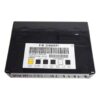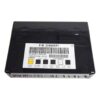Restore Your GM Truck’s Electrical System with a VIN-Programmed BCM
Are you battling bizarre electrical issues in your 2010 Suburban 1500? Flickering dash lights, power windows with a mind of their own, or a security system that prevents your truck from starting can be incredibly frustrating. As a technician with over two decades of experience, I’ve seen these exact problems hundreds of times. The culprit is almost always a failing Body Control Module (BCM), the central command center for your vehicle’s body electronics.
This isn’t just a replacement part; it’s a complete, hassle-free solution. We take a genuine OEM BCM and program it with the latest GM software specifically for your vehicle using the VIN you provide. This means you can skip the expensive trip to the dealership for programming. It arrives at your door ready for installation, saving you time, money, and headaches.
A Technician’s Notebook: The Case of the Haunted Suburban
I remember a 2010 Suburban that came into my bay with a list of complaints that sounded like something from a ghost story. The radio would switch stations randomly, the interior lights would pulse, and occasionally, the truck just wouldn’t start—only the security light would flash. The owner had already replaced the battery and checked the grounds. After connecting my scan tool, I found a slew of U-codes (communication errors) pointing to the BCM. Instead of a costly and time-consuming dealer replacement, we installed one of our pre-programmed modules. The entire job took less than an hour, and every single electrical gremlin was gone. This is the power of a correctly programmed, reliable part.
Common Signs of a Failing BCM
A faulty BCM can cause a wide range of symptoms that may seem unrelated. If your vehicle is experiencing any of the following, a new 2010 Suburban Body Control Module is likely the solution:
- ✔ Erratic or non-functional power windows, door locks, and interior/exterior lights.
- ✔ The security or anti-theft system light stays on, causing a no-start condition.
- ✔ Dashboard gauges behaving erratically or not working at all.
- ✔ Communication error codes, such as U0140, U0155, or other U-series codes, stored in the system.
- ✔ The horn sounding unexpectedly or not working when pressed.
- ✔ Intermittent issues with the radio or climate control functions.
A Straightforward Guide to Installation
Installing your new 2010 Suburban Body Control Module is a manageable job for a confident DIYer. For the 2010 Suburban, the BCM is typically located under the driver’s side of the dashboard, near the steering column.
- Safety First: Always disconnect the negative terminal from your vehicle’s battery before beginning any electrical work.
- Locate the Module: Remove the lower dash panel beneath the steering wheel to gain access to the BCM. It’s a black box with several large electrical connectors.
- Disconnect and Remove: Carefully release the locking tabs on each electrical connector and unplug them from the old BCM. Then, unbolt or unclip the module from its mounting bracket and remove it.
- Install the New BCM: Mount the new, pre-programmed BCM in the same location. Securely plug in all the electrical connectors, ensuring they click into place.
- Reconnect and Test: Reinstall the dash panel, reconnect the negative battery terminal, and start the vehicle. Test all functions like windows, locks, lights, and radio to confirm the repair.
Important Post-Installation Note: In some cases, additional steps may be required. If your airbag light is on, a professional scan tool is needed to perform the “Setup SDM Primary Key in BCM” procedure. A “Brake Pedal Position Relearn” may also be necessary. Always consult a factory service manual for vehicle-specific details.
Verified Vehicle Compatibility
This BCM, part number 15948439, is a direct replacement for a wide range of GM vehicles and part numbers, ensuring you get the right component. Please verify your vehicle’s make, model, and year against this list. This module replaces the following part numbers: 10382479, 15093910, 15276271, 15299986, 15819552, 15828601, 15837419, 15872388, 15872421, 15880684, 15921352, 15921353, 15948438, 15948439, 20815898, 20839063, 20864767, 20864768, 20921435, 20921436, 20935349, 22860591, 25826124, 25826125, 25847588, 25847589, 25892622, 25910474, 25934762, 25934763, 95151084.
AVALANCHE 1500 10 Body Control (BCM); (under steering column), ID 25892622
CAPRICE 11-13 Body Control (BCM)
CAPTIVA SPORT 12 Body Control (BCM); (center dash), ID 20921435, 20921436, 22860591
CTS 08-13 Body Control (BCM); LH dash
DTS 06-11 Body Control (BCM); (RH center dash)
ENCLAVE 08-12 Body Control (BCM); (LH dash)
EQUINOX 07-09 Body Control (BCM); (center dash)
ESCALADE 10 Body Control (BCM); (under steering column), ID 20815898 or 25892622
ESCALADE ESV 10 Body Control (BCM); (under steering column), ID 20815898 or 25892622
ESCALADE EXT 10 Body Control (BCM); (under steering column), ID 25892622
EXPRESS/SAVANA VANS 08-12 Body Control (BCM)
G8 08-09 Body Control (BCM); (center dash)
HUMMER H2 08-09 Body Control (BCM); (LH firewall)
IMPALA 06-13 Body Control (BCM); (LH dash)
LUCERNE 06-11 Body Control (BCM); (right side dash)
MONTE CARLO 06-07 Body Control (BCM); (LH steering column)
OUTLOOK 07-10 Body Control (BCM); (center dash)
SRX 07-09 Body Control (BCM); LH dash
STS 10 Body Control (BCM); center dash
SUBURBAN 1500 10 Body Control (BCM); (under steering column), ID 20815898 or 25892622
TAHOE 10 Body Control (BCM); (under steering column), ID 20815898 or 25892622
TORRENT 07-09 Body Control (BCM); (center dash)
TRAVERSE 09-12 Body Control (BCM); (LH dash)
VUE 08-10 Body Control (BCM); (center dash)
YUKON 10 Body Control (BCM); (under steering column), ID 20815898 or 25892622
YUKON XL 1500 10 Body Control (BCM); (under steering column), ID 20815898 or 25892622
Frequently Asked Questions
2010 Suburban Body Control Module
Is this a difficult part to install myself?
For someone with basic mechanical skills, it is a straightforward installation. The main challenge is accessing the module under the dashboard. Since our comes pre-programmed, you avoid the most complex part of the job.


